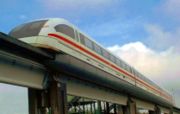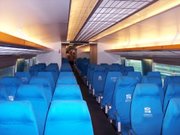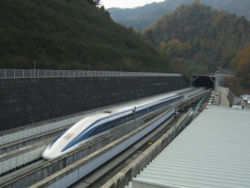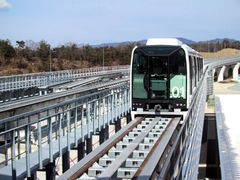Maglev train
2007 Schools Wikipedia Selection. Related subjects: Railway transport

Magnetic levitation transport, or maglev, is a form of transportation that suspends, guides and propels vehicles via electromagnetic force. This method can be faster and more comfortable than wheeled mass transit systems. Maglevs could potentially reach velocities comparable to turboprop and jet aircraft (500 to 580 km/h). Since much of a Maglev's propulsion system is in the track rather than the vehicle, Maglev trains are lighter and can ascend steeper slopes than conventional trains. They can be supported on lightweight elevated tracks. Maglevs have operated commercially since 1984. However, scientific and economic limitations have hindered the proliferation of the technology.
Maglev technology has minimal overlap with wheeled train technology and is not compatible with conventional railroad tracks. Because they cannot share existing infrastructure, maglevs must be designed as complete transportation systems. The term "maglev" refers not only to the vehicles, but to the vehicle/guideway interaction; each being a unique design element specifically tailored to the other to create and precisely control magnetic levitation and propulsion.
The world's first commercial application of a high-speed maglev line is the IOS (initial operating segment) demonstration line in Shanghai that transports people 30 km (18.6 miles) to the airport in just 7 minutes 20 seconds (top speed of 431 km/h or 268 mph, average speed 250 km/h or 150 mph). Other maglev projects worldwide are being studied for feasibility.
Technology
There are two primary types of maglev technology:
- electromagnetic suspension (EMS) uses the attractive magnetic force of a magnet beneath a rail to lift the train up.
- electrodynamic suspension (EDS) uses a repulsive force between two magnetic fields to push the train away from the rail.
Electromagnetic suspension
In current EMS systems, the train levitates above a steel rail while electromagnets, attached to the train, are oriented toward the rail from below. The electromagnets use feedback control to maintain a train at a constant distance from a track.
Electrodynamic suspension
In Electrodynamic suspension (EDS), both the rail and the train exert a magnetic field, and the train is levitated by the repusive force between these magnetic fields. The magnetic field in the train is produced by either superconducting electromagnets (as in JR-Maglev) or by an array of permanent magnets (as in Inductrack). The repulsive force in the track is created by an induced magnetic field in wires or other conducting strips in the track.
At slow speeds, the current induced in these coils and the resultant magnetic flux is not large enough to support the weight of the train. For this reason the train must have wheels or some other form of landing gear to support the train until it reaches a speed that can sustain levitation.
Propulsion coils on the guideway are used to exert a force on the magnets in the train and make the train move forwards. The propulsion coils that exert a force on the train are effectively a linear motor: An alternating current flowing through the coils generates a continuously varying magnetic field that moves forward along the track. The magnets on the train line up with this field, and the train moves.
Pros and cons of different technologies
Each implementation of the magnetic levitation principle for train-type travel involves advantages and disadvantages. Time will tell as to which principle, and whose implementation, wins out commercially.
|
|
||||
| Technology | Pros | Cons | ||
|
|
||||
| EMS (Electromagnetic) | Magnetic fields inside and outside the vehicle are insignificant; proven, commercially available technology that can attain very high speeds (500 km/h); no wheels or secondary propulsion system needed | The separation between the vehicle and the guideway must be constantly monitored and corrected by computer systems to avoid collision due to the unstable nature of electromagnetic attraction. | ||
|
|
||||
| Superconducting EDS (Electrodynamic) | Powerful onboard superconducting magnets and large margin between rail and train enable highest recorded train speeds (581 km/h) and heavy load capacity; has recently demonstrated (Dec 2005) successful operations using high temperature superconductors ( HTS) in its onboard magnets, cooled with inexpensive liquid nitrogen | Strong magnetic fields onboard the train make the train inaccessible to passengers with pacemakers or magnetic data storage media such as hard drives and credit cards; vehicle must be wheeled for travel at low speeds; system per mile cost still considered prohibitive; the system is not yet out of prototype phase. | ||
|
|
||||
| Inductrack System (Permanent Magnet EDS) | Failsafe Suspension - no power required to activate magnets; Magnetic field is localized below the car, can generate enough force at low speeds (around 5 km/h) to levitate maglev train; in case of power failure cars slow down on their own in a safe, steady and predictable manner before coming to a stop; Halbach arrays of permanent magnets may prove more cost-effective than electromagnets | Requires either wheels or track segments that move for when the vehicle is stopped. New technology that is still under development ( as of 2006) and has as yet no commercial version or full scale system prototype. | ||
|
Neither Inductrack nor the Superconducting EDS are able to levitate vehicles at a standstill, although Inductrack provides levitation down to a much lower speed. Wheels are required for both systems. EMS systems are wheel-less. The German Transrapid, Japanese HSST (Linimo), and Korean Rotem maglevs levitate at a standstill, with electricity extracted from guideway using power rails for the latter two, and wirelessly for Transrapid. If guideway power is lost on the move, the Transrapid is still able to generate levitation down to 10 km/h speed, using the power from onboard batteries. This is not the case with the HSST and Rotem systems. PropulsionAn EMS system can provide both levitation and propulsion using an onboard linear motor. EDS systems can only levitate the train using the magnets onboard, not propel it forward. As such, vehicles need some other technology for propulsion. A linear motor (propulsion coils) mounted in the track is one solution. Over long distances where the cost of propulsion coils could be prohibitive, a propeller or jet engine could be used. StabilityStatic magnetic bearings using only electromagnets and permagnets are unstable, as explained by Earnshaw's theorem. As all EDS systems are moving systems, Earnshaw's theorem does not apply to them. EMS systems rely on active electronic stabilization. Such systems constantly measure the bearing distance and adjust the electromagnet current accordingly. Pros and cons of maglev vs. conventional trainsDue to the lack of physical contact between the track and the vehicle, the only friction experienced by a maglev train is due to air resistance (although maglev trains also experience electromagnetic drag, this is relatively small at high speeds). The power consumption per passenger-km of the Transrapid Maglev train at 200 km/h is 24% less than the ICE at 200 km/h (22 Wh per seat-km, compared to 29 Wh per seat-km). Because maglev trains do not run on rails, their speed is not limited by the tolerances of track designs. Systems have been proposed that operate at up to 650 km/h (404 mph), which is far faster than is practical with conventional rail transport. The very high maximum speed potential of maglevs make them potential competitors to airline routes of 1,000 kilometers (600 miles) or less. The weight of the large electromagnets in EMS and EDS designs are a major design issue. A very strong magnetic field is required to levitate a massive train. For this reason one research path is using superconductors to improve the efficiency of the electromagnets. In April 2004, a peer-reviewed article in the Journal of the Acoustical Society of America stated that the noise from high-speed maglev trains is considerably more disturbing than standard steel on steel intercity train noise and is approximately as disturbing as road traffic. The difference between equal disturbance levels of maglev and traditional trains was 5dB (about 78% noisier). Maglev is characterized by high noise levels and brief duration, which may startle those underneath the track. The type of noise a maglev emits is similar to a jet aircraft, due to the speed and shape of the maglev train. EconomicsHigh-speed maglevs can be expensive to build, but are comparable to the capital costs of building a traditional high-speed rail system from scratch, a highway system or a system of airports. More importantly, maglevs are significantly less expensive to operate and maintain than traditional high-speed trains, planes or intercity buses. The data coming out of the Shanghai maglev demonstration project indicates that operation and maintenance costs are quite low, and are indeed covered by the current relatively low volume of 7,000 passengers per day. Passenger volumes on this Pudong International Airport line is expected to rise dramatically once the line is extended from Longyang Road metro station all the way to Shanghai's downtown train depot. The Shanghai maglev cost US$1.2 billion to build. At US$6 per passenger and 20,000 passengers per day, it would take over 27 years just to repay the capital costs (including cost of financing), not accounting for track maintenance, salaries and electricity (see solar power).This computes to US$60 million per mile. The total $1.2 billion includes infrastructure capital costs such as manufacturing and construction facilities, and operational training, as part of the calculated per-mile cost of the short track. It is predicted that the per-mile costs of the extension to Hangzhou will be significantly lower. The proposed Chūō Shinkansen line is estimated to cost approximately US$ 82 billion to build. However, when one considers the cost of airport construction (e.g., Hong Kong Airport cost US$20 billion to build in 1998) and eight-lane Interstate highway systems that cost around US$50 million per mile, it becomes immediately apparent that maglev's costs are competitive, especially considering that they can handle much higher volumes of passengers per hour than airports or eight-lane highways and do it without introducing any air pollution along the right of way. The only low-speed maglev (100 km/h) currently operational, the Japanese Linimo HSST, cost approximately US$100 million/km to build. Besides offering improved O&M costs over other transit systems, these low-speed maglevs provide ultra-high levels of operational reliability and introduce little noise and zero air pollution into dense urban settings. As maglev systems are deployed around the world, experts expect construction costs to drop as new construction methods are perfected. Existing maglev systemsBirmingham 1984–1995The world's first commercial automated system was a low-speed maglev shuttle that ran from the airport terminal of Birmingham International Airport (UK) to the nearby Birmingham International railway station from 1984 to 1995. Based on experimental work commissioned by the British government at the British Rail Research Division laboratory at Derby, the length of the track was 600 m, and trains "flew" at an altitude of 15 mm. It was in operation for nearly eleven years, but obsolescence problems with the electronic systems made it unreliable in its later years and it has now been replaced with a cable-drawn system. Berlin 1989–1991In West Berlin, the M-Bahn was built in the late 1980s. It was a driverless maglev system with a 1.6 km track connecting three stations. Testing in passenger traffic started in August 1989, and regular operation started in July 1991. Although the line largely followed a new elevated alignment, it terminated at the U-Bahn station Gleisdreieck, where it took over a platform that was then no longer in use; it was from a line that formerly ran to East Berlin. After the fall of the Berlin Wall, plans were set in motion to reconnect this line (today's U2). Deconstruction of the M-Bahn line began only two months after regular service began and was completed in February 1992. Emsland, GermanyTransrapid, a German maglev company, has a test track in Emsland with a total length of 31.5 km. JR-MaglevJapan has a test track in Yamanashi prefecture where test trains JR-Maglev MLX01 have reached 581 km/h (361 mph), faster than wheeled trains. These trains use superconducting magnets which allow for a larger gap, and repulsive-type "Electro-Dynamic Suspension" (EDS). In comparison Transrapid uses conventional electromagnets and attractive-type "Electro-Magnetic Suspension" (EMS). These "Superconducting Maglev Shinkansen", developed by the Central Japan Railway Co. ("JR Central") and Kawasaki Heavy Industries, are currently the fastest trains in the world, achieving a record speed of 581 km/h on December 2, 2003. Linimo (Tobu Kyuryo Line)The world's first commercial automated " Urban Maglev" system commenced operation in March 2005 in Aichi, Japan. This is the nine-station 8.9 km long Tobu-kyuryo Line, otherwise known as the Linimo. The line has a minimum operating radius of 75 m and a maximum gradient of 6%. The linear-motor magnetic-levitated train has a top speed of 100 km/h. The line serves the local community as well as the Expo 2005 fair site. The trains were designed by the Chūbu HSST Development Corporation, which also operates a test track in Nagoya. Urban-type maglevs patterned after the HSST have been constructed and demonstrated in Korea, and a Korean commercial version Rotem is now under construction in Daejeon and projected to go into operation by April of 2007. FTA's UMTD programIn the US, the Federal Transit Administration (FTA) Urban Maglev Technology Demonstration program has funded the design of several low-speed urban maglev demonstration projects. It has assessed HSST for the Maryland Department of Transportation and maglev technology for the Colorado Department of Transportation. The FTA has also funded work by General Atomics at California University of Pennsylvania to demonstrate new maglev designs, the MagneMotion M3 and of the Maglev2000 of Florida superconducting EDS system. Other US urban maglev demonstration projects of note are the LEVX in Washington State and the Massachusetts-based Magplane. Southwest Jiaotong University, ChinaOn December 31, 2000, the first crewed high-temperature superconducting maglev was tested successfully at Southwest Jiaotong University, Chengdu, China. This system is based on the principle that bulk high-temperature superconductors can be levitated or suspended stably above or below a permanent magnet. The load was over 530 kg and the levitation gap over 20 mm. The system uses liquid nitrogen, which is very cheap, to cool the superconductor. The first, the German patent (1941)The first patent for a magnetic levitation train propelled by linear motors was German Patent 707032, issued in June 1941. The US patent 12700 date 1st October 1907 was for a linear motor propelled train in which the motor, below the steel track, carried some but not all of the weight of the train ( inventor Alfred Zehden of Frankfurt-am-Main ) Under constructionOld Dominion UniversityA track of less than a mile in length has been constructed at Old Dominion University in Norfolk, Virginia. The system is not operational, but research is currently ongoing to resolve some stability issues with the system. This system uses a "smart train, dumb track" that involves most of the sensors, magnets, and computation occurring on the train rather than the track. This system will cost less to build per mile than existing systems. The same principle is involved in the construction of a second prototype system in Powder Springs, Georgia, by American Maglev Technology, Inc., set for deployment in Fall 2006. ProposalsEuropeMunichA Transrapid connection of the Bavarian capital Munich to its international airport (37 km) is now being planned. It would reduce the current connection time via S-Bahn (German city railroad system) from about 40 minutes to 10 minutes. Berlin – HamburgA 292 km Transrapid line linking Berlin to Hamburg. It has been cancelled due to lack of funds. Instead the existing railway line has been upgraded to 230 km/h for ICE train sets. London – Edinburgh and/or GlasgowA maglev line has recently been proposed in the United Kingdom from London to Edinburgh and/or Glasgow with several route options through the Midlands, Northwest and Northeast, and is reported to be under favourable consideration by the government. A further high speed link is also being investigated as an option between Glasgow to Edinburgh though there is no settled technology for this concept yet, ie (Maglev/Hi Speed Electric etc) AsiaTokyo – OsakaIf a proposed Chūō Shinkansen is built, connecting Tokyo to Osaka by maglev, the existing test track in Yamanashi prefecture would be part of the line. Shanghai – HangzhouChina has decided to build a second Transrapid maglev rail with a length of 160 km from Shanghai to Hangzhou ( Shanghai-Hangzhou maglev line). Talks with Germany and Transrapid Konsortium about the details of the construction contracts have started. On March 7, 2006, the Chinese Minister of Transportation was quoted by several Chinese and Western newspapers as saying the line was approved. Construction will probably start towards the end of 2006 and is scheduled to be completed in time for the 2010 Shanghai Expo, becoming the first inter-city Maglev rail line in commercial service in the world. The line will be an extension of the Shanghai airport Maglev line. Johor, MalaysiaMalaysia has decided to use Mag-lev technology to link important landmarks across the city. This will be a boost to business to compete against the neighbouring city, Singapore. USALos Angeles, Southern California – Las VegasHigh-speed maglev lines between major cities of southern California and Las Vegas are also being studied via the California-Nevada Interstate Maglev Project. This plan was originally supposed to be part of a I-5 or I-15 expansion plan, but the federal government has ruled it must be separated from interstate work projects. Since the federal government decision, private groups from Nevada have proposed a line running from Las Vegas to Los Angeles with stops in Primm, Nevada; Baker, California; and points throughout Riverside County into Los Angeles. Southern California politicians have not been receptive to these proposals; many are concerned that a high speed rail line out of state would drive out dollars that would be spent in state "on a rail" to Nevada. Baltimore – Washington, D.C.A 64 km project linking Camden Yards in Baltimore and Baltimore-Washington International (BWI) Airport to Union Station in Washington, D.C. It is in demand for the area due to its current traffic/congestion problems. The project is in contention for the same federal grant as the Pittsburgh project. Florida High Speed RailThe history of High Speed Rail in Florida started in 1976 with feasibility study for service between Daytona Beach and St. Petersburg. In November of 2000, the Florida voters approved an amendment to the State constitution mandating the construction of a High Speed Transportation system to link the five largest urban areas in Florida. Construction was mandated to begin by November 1, 2003. In October 2002, the Authority issued a Request for Proposal to Design, Build, Operate, Maintain and Finance (DBOM&F) the first phase of the project from Tampa to Orlando. Based on Fluor Bombardier (FB) proposal first and the Global Rail Consortium (GRC) proposal, the cost of initial phase is approximately $2.4 billion. In early 2004, Governor Jeb Bush endorsed an effort to repeal the 2000 amendment that mandated the construction of the High Speed Rail System which was approved by the voters, resulting in removal of the constitutional mandate. The Florida High Speed Rail Authority Act is still remains in effect pending any action from the Florida Legislature. In fiscal year 2004/05, no State funds were appropriated, and the Authority has operated on surplus funds from previous years. HonoluluThe city of Honolulu, Hawaii is said to be planning a Linimo class urban Maglev for its main mass transit train. San DiegoSan Diego is considering a high-speed maglev line to serve as a passenger transportation node to remote airport sites under consideration. The cost estimate is approximately $10 billion U.S. for the 120-150 km (80-100 mile) run, not including the cost of construction of the airport. The Cascadia MaglevLong-proposed but not on any official drawing boards would be a Maglev line along the Interstate 5 corridor, its core component from Portland, Oregon to Vancouver, British Columbia, with eventual extensions to Eugene, Oregon (in the south) and Whistler, British Columbia (in the north). The initial phase of the project would link Tacoma to Seattle, mirroring the old interurban line between those two cities. The same idea has re-surfaced with a conventional high-speed rail proposal, although its extension into British Columbia has been largely blocked by opposition on the part of the City of White Rock, British Columbia, which would sit astride the line. VactrainMore exotic proposals include maglev lines through vacuum-filled tunnels (see Vactrain), where the absence of air resistance would allow extremely high speeds, up to 6000-8000 km/h (4000-5000 mph) according to some sources. Theoretically, these tunnels could be built deep enough to pass under oceans or to use gravity to assist the trains' acceleration. This would likely be prohibitively costly without major advances in tunnelling technology. Alternatives such as elevated concrete tubes with partial vacuums have been proposed to reduce these costs. If the trains topped out at around 8000 km/h (5000 mph), the 5567km trip between London and New York would take a short 54 minutes, effectively supplanting aircraft as the world's fastest mode of public transportation. UniModalUniModal is a personal rapid transit idea that proposes to use Inductrack suspension to achieve speeds of 160 km/h (100 mph). Most significant accidents and incidentsAugust 11, 2006 fireOn August 11, 2006 a fire broke out on the Shanghai commercial Transrapid, shortly after leaving the terminal in Longyang. September 22, 2006 crashOn September 22, 2006 an elevated Transrapid train collided with a maintenance vehicle on a test run in Lathen (Lower Saxony / north-western Germany). Twenty five people were killed, and ten people were injured. These were the first fatalities resulting from a Maglev train accident. |
||||




